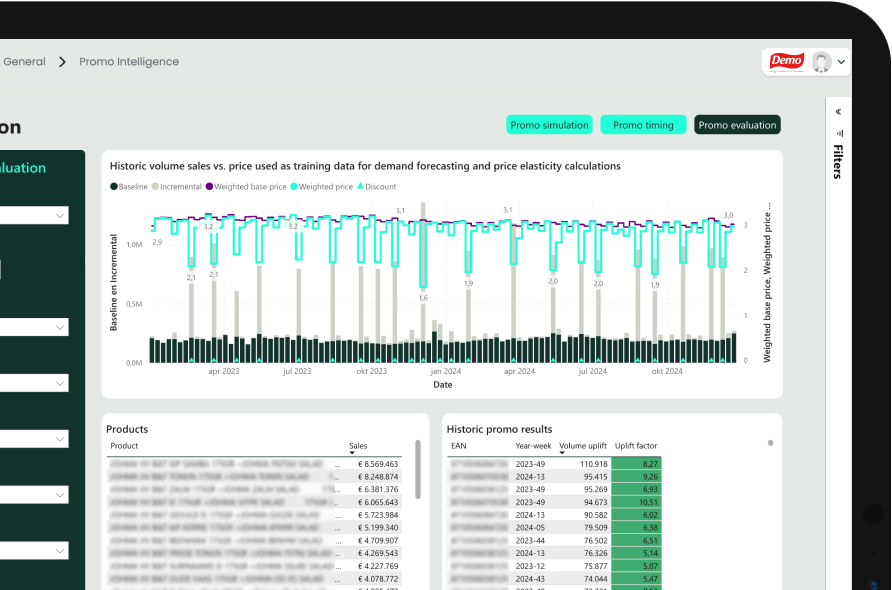
4 Tips to become a datadriven storyteller
As a Category Manager or Trade Marketer, it’s not just about showing data, it’s about turning it into a story that drives action. Here’s how to do it smarter in 4 tips:
Add value to the table
As a Category Manager or Trade Marketeer, you want to add value at the table with your retailers. That retailers themselves have access to a lot of data and conduct their own analyses is nothing new. It varies by retailer, but generally speaking, Dutch retailers are quite advanced in their data analytics. However, when we listen to our retail suppliers who also operate internationally, it’s clear that retail is much less mature when it comes to data & analytics. Still, as a supplier, you can make a real difference with the data and insights you bring to the table. But how do you do that smartly? What’s your added value or unique insight? We’ve got 4 tips for you.


A fresh perspective
With Captain, we want to bring a fresh perspective to Category Management. What do we mean by that? A smarter way to get to insights that allow you to truly add value in conversations with your retailer. Turning raw data into insights that are clear, convincing, and action-oriented, in an efficient way, powered by AI. It’s not just about sharing data or insights, it’s about creating impact together in your category. By telling your story, backed by unique insights.
#1 One-size-fits-none
Every retailer operates a little differently, has different goals, and values different things. A single, standard report doesn’t always work. You need to find the story that’s relevant to that specific retailer. That’s how you make a difference.
That’s why it’s smart to present insights that truly match what they need — helping them reach their goals and make an impression with their team or leadership. Whether it’s fair share analyses, store-level rotation, promotion or distribution analysis, or something else entirely.
So how do you do that? Ask your partners about their biggest business goals and what kind of data they’d like to see. That way, you can deliver the right insights in a format that’s logical and valuable to them. You can then standardize these reports for that specific retailer for your next meeting.
#2 Breaking news!
Okay, maybe that’s a bit dramatic — but your story will stick if it’s unexpected, if it’s unique. Your data shouldn’t just be a list of what the retailer already knows. Data doesn’t automatically tell the story your retail partner wants to hear. It’s up to you to uncover the hidden opportunities — that’s where your value as a partner shines.
Always include a clear conclusion: “…and this means that…” Your power lies in connecting separate signals into one actionable recommendation. For example: you notice that soft cheese sales — like brie and camembert — have remained surprisingly high since the holidays. At the same time, shopper data shows that consumers are increasingly opting for premium at-home snack moments. Your insight and recommendation? “This is the perfect time to tap into the growing demand for ‘premium at-home experiences’ trend: expand the premium cheese assortment, create cross-promotions with appetizer wines, and inspire shoppers with content around cheese boards and pairing suggestions.”
#3 Strong visuals = a strong story
If you want to persuade, you need to present your data clearly and visually. Our brains think in images, so make sure your charts are clear, appealing, and to the point — ideally in your own brand style. Fortunately, there are plenty of guides and platforms — like Captain — that help you present data in a visually compelling way. Also, take time to reflect on what works: compare strong visuals to weaker ones and learn to spot the difference (tailored per retailer, of course).
#4 Use a consistent structure
Our brains don’t just respond well to visuals — structure is just as important. Tell a story with a beginning and an end, and turn your presentation method into a repeatable formula. That way, your insights consistently add value for your retailers. And they’ll know exactly how to act on your story — so much so, they’ll be looking forward to your next visit.
Here’s a structure that works:
- Set the scene. Show how you arrived at your insight. This builds credibility. For example: you found a link between the rise in premium cheese sales and a trend report on more luxurious at-home snacking moments.
- Bring the story to life. Give your data a face. Use “characters” like shoppers or consumers. For example: explain how consumers have discovered five new ways to gather, with cheese at the heart of those moments.
- End with an action. Translate your insight into a clear recommendation. For example: suggest creating a cheese board display in the fresh section, including pairing suggestions with wine and nuts.
When you understand your audience, tell a clear story, and bring your insights to life visually — you’re not just delivering data, you’re driving impact. And that’s exactly where Captain comes in. Captain fully automates the process from data to unique insights, so you can focus on telling the story. That’s where you, as a Category Manager or Trade Marketeer, shine. That’s where you make the difference.
You are the captain. This is your story.


Article written by
Roy van Beest


